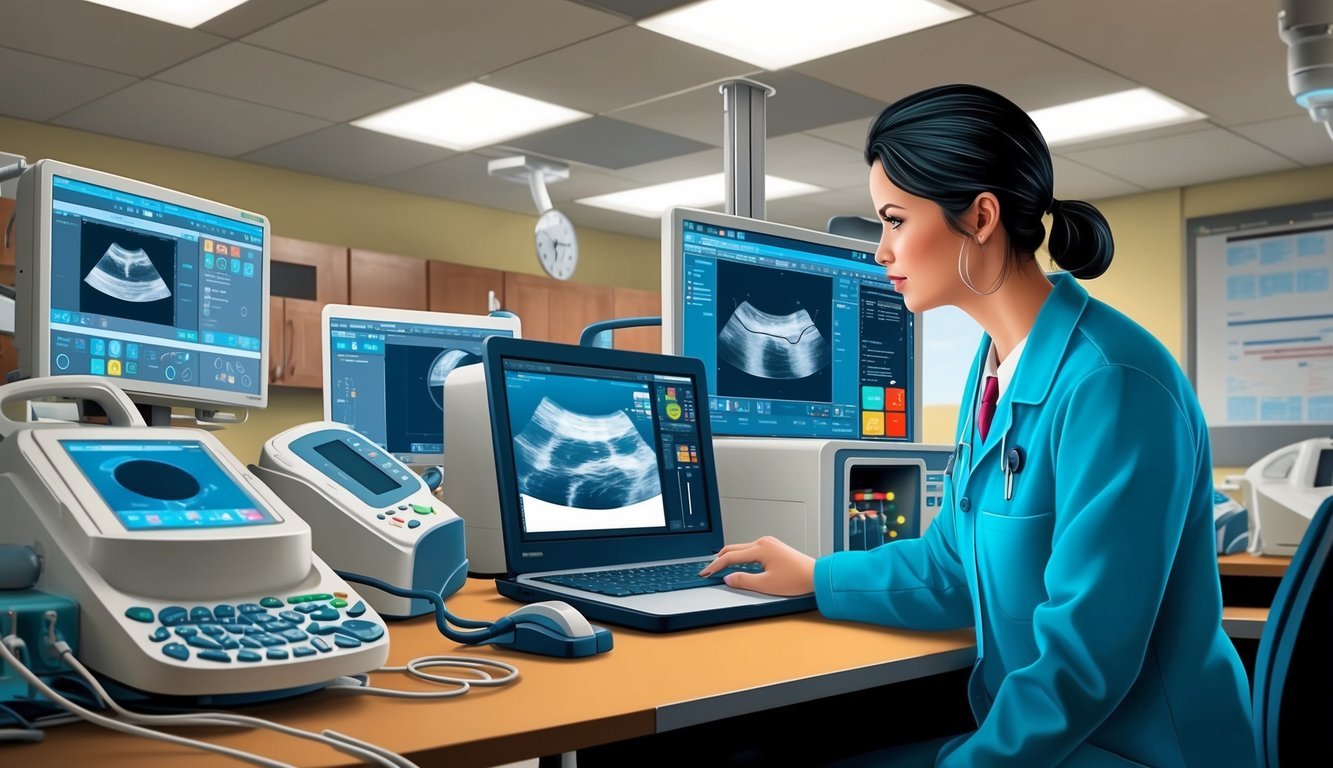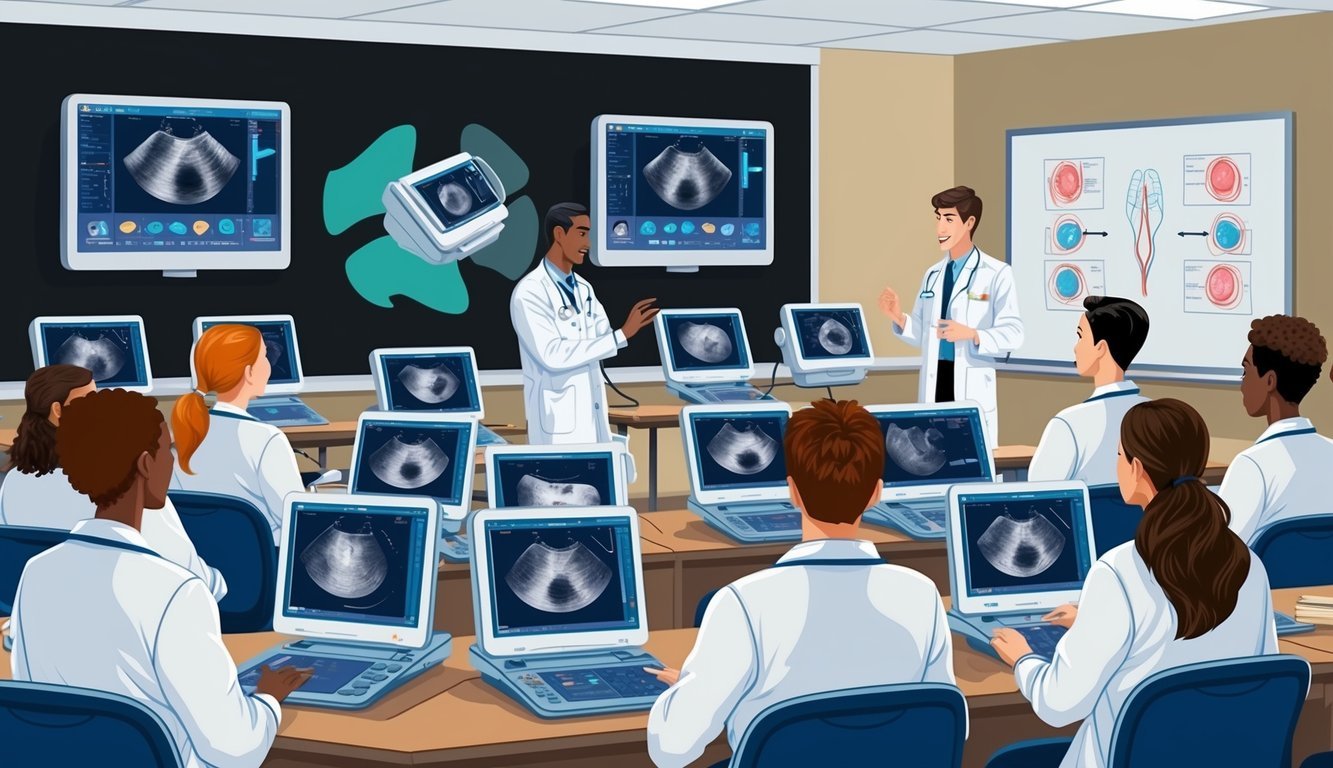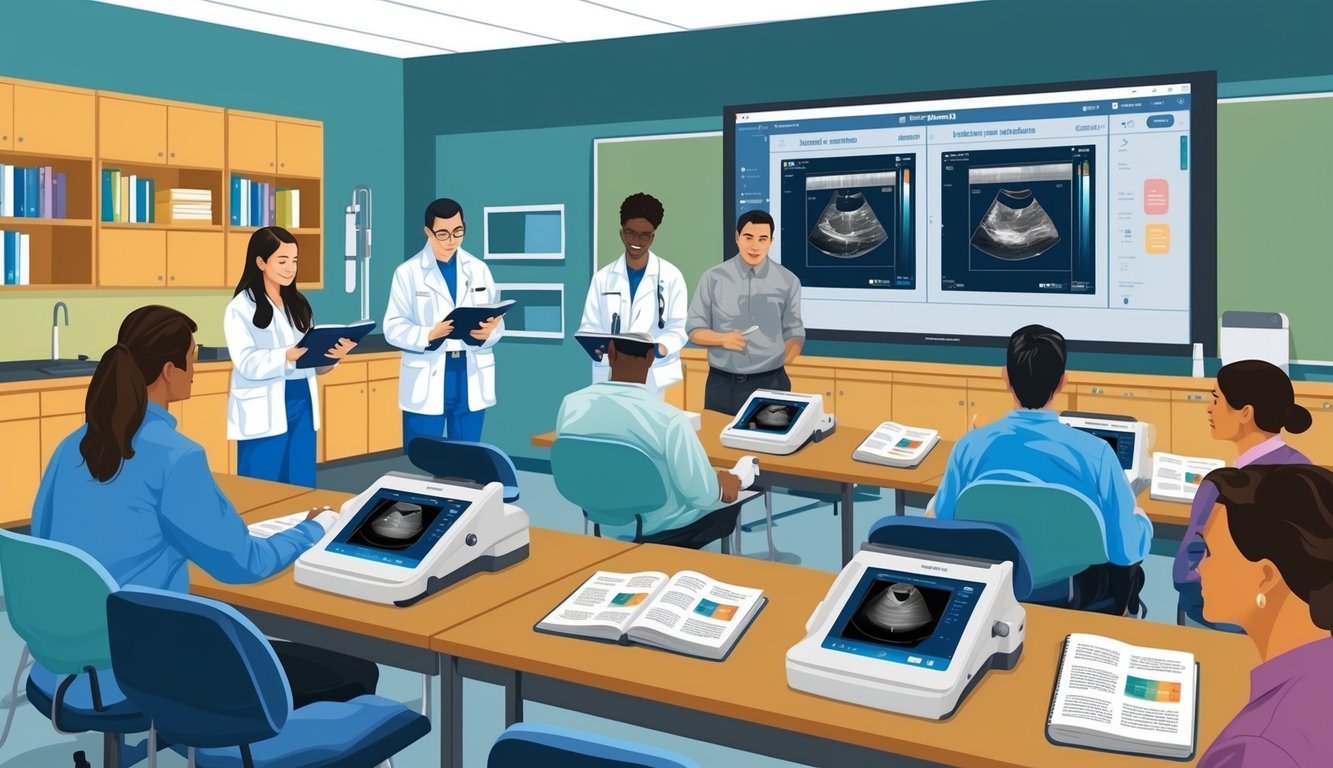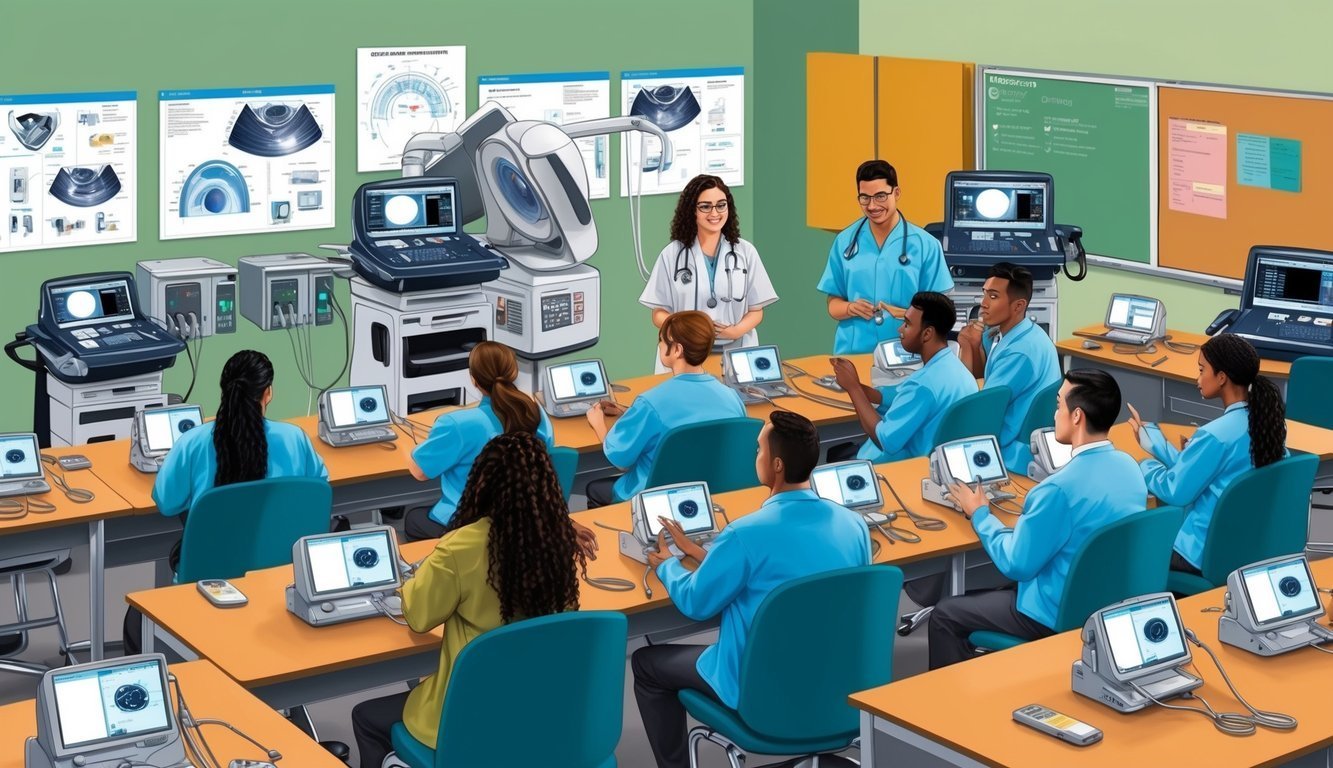Finding the right educational path in sonography can significantly impact your career in the healthcare field.
You can find several options that cater to different needs and timelines if you’re looking for accredited sonography programs near you.
These programs can range from certificate courses to degree-granting institutions, depending on your goals and experience level.
To help you in your search, you can explore various resources that provide comprehensive listings of accredited programs.
Websites like Ultrasound Schools Info offer a detailed directory of CAAHEP-accredited sonography schools throughout the United States.
Additionally, institutions such as Johns Hopkins provide hands-on training within a structured program, preparing you for a rewarding career.
With the growing demand for skilled sonographers, selecting the right program is crucial.
Whether you are seeking a quick certificate or a full degree, your options are extensive and accessible, ensuring that you can find the program that meets your needs.
Understanding Sonography

Sonography involves the use of high-frequency sound waves to create images of internal body structures.
This technique is critical in diagnosing medical conditions and requires skilled professionals who understand both the physics behind the technology and the biological contexts in which it is applied.
Fundamentals of Medical Sonography
Medical sonography is a non-invasive imaging technique that employs ultrasound waves to visualize internal organs and tissues.
The process begins with a transducer, which emits high-frequency sound waves.
These waves travel through the body and reflect off internal structures.
Key aspects include:
- Applications: Used in obstetrics, cardiology, and diagnostics for abdominal and vascular conditions.
- Advantages: Offers real-time imaging, making it effective for monitoring conditions and guiding biopsies.
- Safety: Unlike X-rays, medical sonography does not involve ionizing radiation, making it safer for patients.
For those seeking accredited programs, consider exploring sonography programs near you.
Role of a Sonographer in Healthcare
As a sonographer, you are responsible for operating ultrasound equipment and ensuring high-quality imaging.
You may perform examinations, analyze images, and assist physicians in diagnosing illnesses.
Your duties include:
- Patient Interaction: Explaining procedures to patients and ensuring their comfort.
- Image Optimization: Adjusting equipment settings to capture the best possible images.
- Collaboration: Working closely with radiologists and other healthcare professionals to discuss findings and implement care plans.
An effective sonographer combines technical skills with a solid understanding of human anatomy and pathology.
Physics and Instrumentation in Sonography
Understanding the physics of sound waves is essential for effective ultrasound imaging.
The two key concepts are frequency and wavelength.
- High-Frequency Sound Waves: Typically range from 2 to 18 MHz, allowing for detailed imaging of soft tissues.
Instrumentation used in sonography includes:
| Instrument | Purpose |
|---|---|
| Transducer | Converts electrical energy to sound waves |
| Doppler Effect | Measures blood flow and velocity |
| Ultrasound Machine | Processes images for display |
By mastering these physics concepts, you enhance your ability to interpret images accurately.
Understanding instrumentation is equally vital as it ensures that you can troubleshoot equipment issues effectively.
Educational Pathways

When pursuing a career in sonography, you have various educational options that allow you to attain the necessary skills and certification.
Selecting the right pathway is crucial for achieving your professional goals in this healthcare field.
Sonography Degree Options
You can choose from different degree options in sonography, primarily an Associate’s or a Bachelor’s degree.
| Degree Type | Duration | Focus Area |
|---|---|---|
| Associate Degree | 2 years | Entry-level sonography training |
| Bachelor’s Degree | 4 years | Advanced sonographic techniques and theory |
An Associate’s degree typically encompasses fundamental clinical skills and prepares you for entry-level positions.
In contrast, a Bachelor’s degree offers a more comprehensive curriculum, covering advanced diagnostic techniques and possibly management courses.
Certificate vs. Bachelor’s Programs
Certificate programs in sonography provide a faster route to entering the field, usually lasting 12-18 months.
These are well-suited for individuals who already possess a background in healthcare.
On the other hand, Bachelor’s programs provide a broader educational foundation, including general education courses and advanced studies in sonographic technology.
You may choose a certificate program if you seek immediate employment or if you already hold a degree in another health-related field.
However, pursuing a Bachelor’s degree prepares you for potential advancement and specialized roles in the future.
Accredited Sonography Programs
Obtaining your degree or certificate from an accredited program is vital for career advancement.
Accreditation ensures that the educational institution meets national educational standards.
Programs accredited by organizations like the Commission on Accreditation of Allied Health Education Programs (CAAHEP) offer a recognized curriculum.
This can significantly enhance your job prospects and eligibility for certification exams.
Make sure to select an accredited sonography program to ensure quality education that meets industry requirements.
General Education and Clinical Training
General education components are often included in degree programs.
Courses in anatomy, physiology, and medical terminology are crucial.
These courses provide a solid foundation for more specialized sonography training.
Clinical training is equally important.
It typically involves hands-on experience in a healthcare setting, allowing you to apply theoretical knowledge in real-world scenarios.
This exposure helps you develop skills critical for successful practice in the field.
Ensuring your program incorporates significant clinical education will prepare you for the varied challenges you will face as a sonographer.
Certification and Licensure

Certification and licensure are crucial steps in establishing your career in sonography.
These credentials not only validate your skills but also enhance your employment opportunities and patient trust.
Importance of ARDMS Certification
The American Registry for Diagnostic Medical Sonography (ARDMS) certification is widely recognized in the field of diagnostic medical sonography.
It demonstrates your expertise and commitment to maintaining high standards in ultrasound practices.
To obtain ARDMS certification, you must pass examinations specific to different areas, such as abdominal sonography and obstetrics.
Achieving this credential can significantly boost your employability, as many employers prefer or require ARDMS credentials for hiring.
You can explore certification details and exam requirements on the ARDMS website.
Other Credentialing Organizations
Beyond ARDMS, there are other credentialing organizations that offer certifications to ultrasound professionals.
The American Registry of Radiologic Technologists (ARRT) provides certifications that are recognized alongside ARDMS credentials.
While ARDMS focuses solely on sonography, ARRT covers a broader range of radiologic technology.
Obtaining certifications from both organizations can differentiate you in a competitive job market.
Understanding the different paths to certification helps you make informed decisions that align with your career goals.
State Licensure Requirements
Licensure requirements for ultrasound technicians can vary significantly by state.
While some states require a specific license for practicing, others may not have formal mandates.
It is essential to check your state’s regulations regarding licensure.
Typically, obtaining a state license involves meeting educational standards, completing a board-approved sonography program, and passing the relevant certification exams.
Many states also require a criminal background check.
You can find specifics about state requirements and approved programs through local regulatory agencies or resources like Ultrasound Schools Info.
Being aware of these requirements ensures that you remain compliant while pursuing your career in sonography.
Specializations in Sonography
Sonography offers various specializations, each focusing on different aspects of medical imaging and patient care.
Understanding these specialties will help you determine which area aligns best with your career goals and interests.
Cardiac Sonography
Cardiac sonographers specialize in imaging the heart and its structures.
They utilize ultrasound technology to create detailed images that help diagnose heart conditions, such as congenital heart defects and valve issues.
You’ll work closely with cardiologists to prepare patients for echocardiograms and interpret the results.
Cardiac sonographers need expertise in anatomy and physiology and must be skilled in patient interaction and technical procedures.
Employers value certifications, like those from the American Registry for Diagnostic Medical Sonography (ARDMS).
The demand for cardiac professionals continues to grow, reflecting the increasing focus on heart health.
Vascular Sonography
Vascular sonographers focus on imaging the blood vessels and circulatory system.
Their primary role is to assess blood flow issues, identify blockages, and evaluate conditions such as deep vein thrombosis and aneurysms.
You will use Doppler ultrasound techniques to provide real-time images of blood flow and collaborate with vascular surgeons to determine treatment plans.
A solid understanding of vascular anatomy is vital for accurate interpretations.
Certification through the ARDMS as a Registered Vascular Technologist (RVT) can enhance your job prospects, reinforcing your credentials in a specialized field that is crucial for patient care.
Obstetrical and Gynecological Sonography
Obstetrical and gynecological sonographers play a critical role in women’s health.
They perform prenatal ultrasounds, which monitor fetal development and assess any potential complications during pregnancy.
You’ll also conduct gynecological ultrasounds to evaluate conditions like ovarian cysts and uterine anomalies.
Your expertise will directly impact patient care, aiding physicians in making informed decisions.
The knowledge of obstetrics, gynecology, and maternal-fetal medicine is essential.
Many facilities require certification in this specialization, ensuring that you are qualified to handle sensitive patient situations and provide accurate imaging results.
Abdominal and Musculoskeletal Sonography
Abdominal sonographers focus on imaging organs within the abdominal cavity, such as the liver, kidneys, and pancreas.
You perform assessments to detect abnormalities like cysts, tumors, and gallstones.
Musculoskeletal sonographers, on the other hand, specialize in imaging muscles, tendons, and joints.
This area requires knowledge of anatomy and the ability to perform dynamic ultrasound examinations.
Both specializations often work hand in hand with other healthcare professionals to diagnose and monitor various conditions.
Consider certification through the ARDMS or other recognized organizations, as it validates your skills and enhances career opportunities in this diverse field.
Careers and Industry Outlook

The field of medical sonography offers diverse career options with a promising job outlook.
Understanding the opportunities available, the future of the industry, and the importance of continuing education is crucial for anyone considering a career as a sonographer.
Job Opportunities and Career Paths
As a registered diagnostic medical sonographer, you will find multiple employment opportunities in various healthcare settings.
Common workplaces include hospitals, clinics, and diagnostic imaging centers.
Potential job titles include:
- Ultrasound Technologist
- Cardiac Sonographer
- Vascular Sonographer
According to the Bureau of Labor Statistics, employment for diagnostic medical sonographers is projected to grow by 11% from 2023 to 2033.
This growth is driven by an increasing emphasis on non-invasive diagnostic imaging and the aging population requiring more medical services.
Future of Medical Sonography
The future of medical sonography looks bright as technology continues to advance.
Innovations such as 3D and 4D imaging, elastography, and portable ultrasound devices are becoming more prevalent.
These advancements improve patient safety and diagnostic accuracy, enhancing the role of sonographers in patient care.
Furthermore, there is a growing commitment to health equity, ensuring all populations have access to quality imaging services.
The integration of sonography with telemedicine also presents promising avenues for remote diagnostics, expanding job opportunities for sonographers.
Continuing Education and Professional Development
To excel in the field, you need continuous education.
Many employers prefer candidates with advanced certifications, such as those offered by the American Registry for Diagnostic Medical Sonography (ARDMS).
Opportunities for continuing education include:
- Online courses
- Workshops
- Professional conferences
Engaging in these activities not only enhances your skills, but also keeps you updated on industry trends.
Staying current in medical sonography benefits not just your career, but also contributes to improved patient outcomes.

